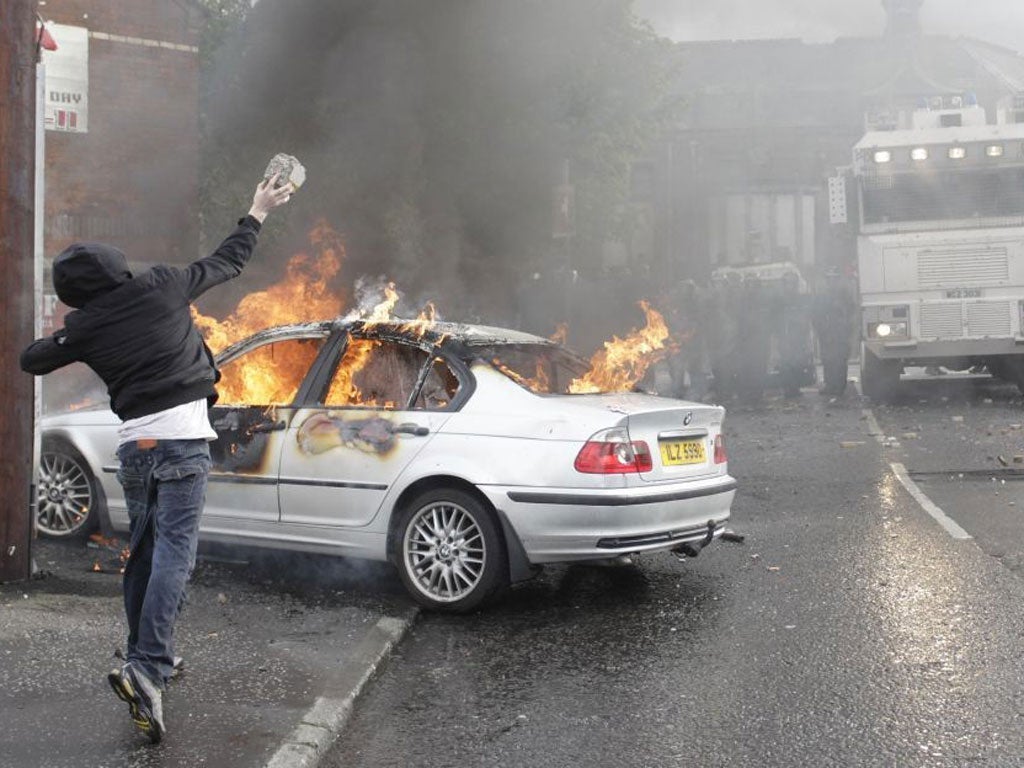Belfast is quiet, but resentment festers
Rioting in Carlisle Circus has its roots in a 200-year-old sectarian feud. David McKittrick reports

Carlisle Circus in north Belfast, where in recent nights dozens of police have been hurt by bricks, stones, bottles and fireworks in savage rioting, was a picture of normality yesterday morning.
People were parking their cars, visiting the hospital, popping into shops and strolling around. No police were to be seen. That was at 10am.
"At a quarter past seven this morning it was like Beirut when I came to open the premises," the manageress of a shop said. "Glass everywhere, bricks, bottles, everything, you name it."
Another shopkeeper agreed: "By eight o'clock, you wouldn't think anything had happened here – they'd tidied the street and cleared away the bricks and whatever else had been thrown."
Some effects of rioting are not so easily remedied: the police casualties include two officers knocked unconscious and another with a broken arm. It is this human cost which led a senior officer to challenge politicians to "sort this out and sort it out now".
Although the rioters included many Catholic teenagers, the crux of the problem lies in the tough loyalist heartland of the Shankill Road district. Most police injuries were inflicted when hundreds of Protestant youths poured out of the Shankill.
The trigger was an unforeseen parading controversy sparked by loyalist bandsmen who played a contentious tune outside a nearby Catholic church. This was condemned as highly disrespectful by both Catholic and Protestant church leaders.
While few have tried to defend what was viewed as a nakedly sectarian incident, it struck a chord among many loyalists who feel "the other side" are doing too well.
A 31-year-old Protestant man who lives within 50 yards of the riot zone said: "There's nothing wrong with the parades. They should go ahead." So was the whole thing about marching? He explained: "It just came to a head because the taigs (Catholics) were getting away with everything, getting everything they want, and we just can't hack it any more."
The Shankill has high unemployment, and he is out of work. He believes it is easier for Catholics to find jobs than Protestants. "Aye, definitely," he said. "They get the work on the building sites and all."
He and others in the immediate district all said the rioters were not local youths but had come in from other parts of the Shankill and elsewhere. "They're not from round here," he said. "Some of them are from ten miles away. It's madness, it's a shambles."
One of his criticisms of police was that they had placed a camera vehicle close to his house: these are used to film disturbances, providing footage which is often later used in prosecutions.
Rioters concentrated on the vehicle, he complained: "It was just antagonising them to throw bricks. Some of them missed the cops and hit our houses. My kids were crying."
An old Protestant lady blamed both sides, saying: "It's six of one and half a dozen of the other. They're a lot of hooligans, the whole lot of them, both sides. The majority of people here are decent hard-working people."
But the marching issue is important to her: "I didn't agree with them playing like that outside a chapel if there's services on.
"But people have strong feelings about marching. It's our heritage, our religion, and I don't believe they should be stopped, not for one minute," she insisted.
A retired man pottering in his little garden added: "I watched it developing. There were people just coming and going here as if it was their own place. Most of them were just onlookers. The cops in my opinion did a good job. The cops are OK – they took care of most of the bother and stood up to it."
The picture is that the riots, while both dangerous and highly telegenic, are localised and the work of a few disaffected elements numbered in the hundreds rather than thousands. There is no sense that entire communities are pitted against each other.
Politicians and community leaders are now urgently seeking to defuse the issue, not least because a major march is scheduled for later this month.
In doing so they will be battling against the tide of history, for the area saw more killings than any other during the Troubles. It witnessed so many that one stretch was known as murder mile.
Carlisle Circus used to feature a statue of "Roaring" Hugh Hanna, a Protestant preacher whose fiery sermons often stirred up rioting. It stood there for decades until, in 1970, it was blown up by republicans.
Even further back, the district has the dubious distinction of being close to the scene of Belfast's first sectarian riot.
This broke out after an Orange march in 1813: next year will be the 200th anniversary of that outbreak, the first of thousands.
Subscribe to Independent Premium to bookmark this article
Want to bookmark your favourite articles and stories to read or reference later? Start your Independent Premium subscription today.

Join our commenting forum
Join thought-provoking conversations, follow other Independent readers and see their replies